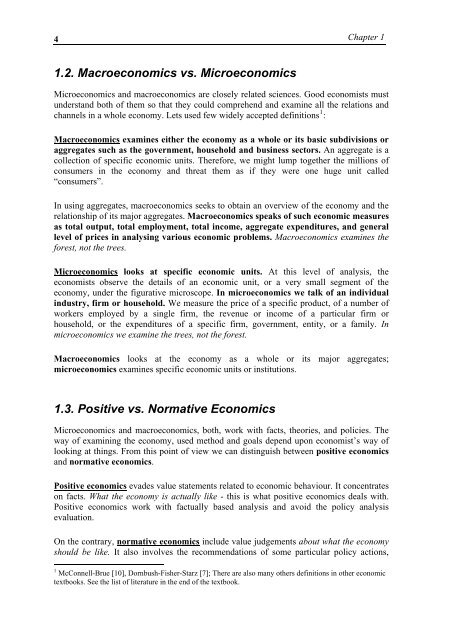MacroeconomicsI_working_version (1)
Create successful ePaper yourself
Turn your PDF publications into a flip-book with our unique Google optimized e-Paper software.
4<br />
Chapter 1<br />
1.2. Macroeconomics vs. Microeconomics<br />
Microeconomics and macroeconomics are closely related sciences. Good economists must<br />
understand both of them so that they could comprehend and examine all the relations and<br />
channels in a whole economy. Lets used few widely accepted definitions 1 :<br />
Macroeconomics examines either the economy as a whole or its basic subdivisions or<br />
aggregates such as the government, household and business sectors. An aggregate is a<br />
collection of specific economic units. Therefore, we might lump together the millions of<br />
consumers in the economy and threat them as if they were one huge unit called<br />
“consumers”.<br />
In using aggregates, macroeconomics seeks to obtain an overview of the economy and the<br />
relationship of its major aggregates. Macroeconomics speaks of such economic measures<br />
as total output, total employment, total income, aggregate expenditures, and general<br />
level of prices in analysing various economic problems. Macroeconomics examines the<br />
forest, not the trees.<br />
Microeconomics looks at specific economic units. At this level of analysis, the<br />
economists observe the details of an economic unit, or a very small segment of the<br />
economy, under the figurative microscope. In microeconomics we talk of an individual<br />
industry, firm or household. We measure the price of a specific product, of a number of<br />
workers employed by a single firm, the revenue or income of a particular firm or<br />
household, or the expenditures of a specific firm, government, entity, or a family. In<br />
microeconomics we examine the trees, not the forest.<br />
Macroeconomics looks at the economy as a whole or its major aggregates;<br />
microeconomics examines specific economic units or institutions.<br />
1.3. Positive vs. Normative Economics<br />
Microeconomics and macroeconomics, both, work with facts, theories, and policies. The<br />
way of examining the economy, used method and goals depend upon economist’s way of<br />
looking at things. From this point of view we can distinguish between positive economics<br />
and normative economics.<br />
Positive economics evades value statements related to economic behaviour. It concentrates<br />
on facts. What the economy is actually like - this is what positive economics deals with.<br />
Positive economics work with factually based analysis and avoid the policy analysis<br />
evaluation.<br />
On the contrary, normative economics include value judgements about what the economy<br />
should be like. It also involves the recommendations of some particular policy actions,<br />
1 McConnell-Brue [10], Dornbush-Fisher-Starz [7]; There are also many others definitions in other economic<br />
textbooks. See the list of literature in the end of the textbook.




